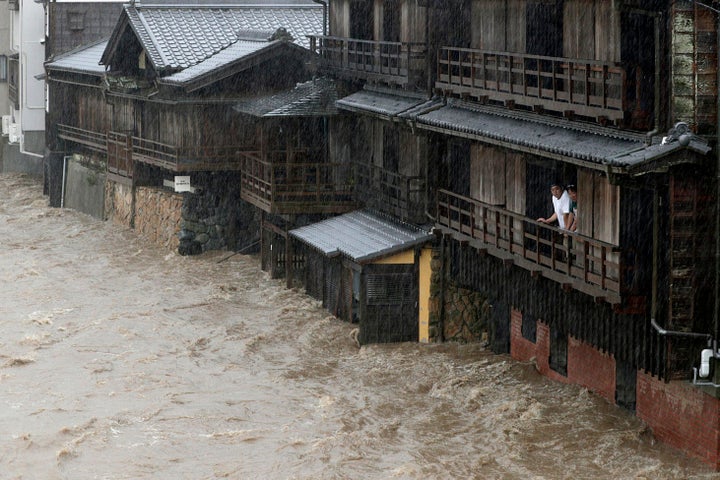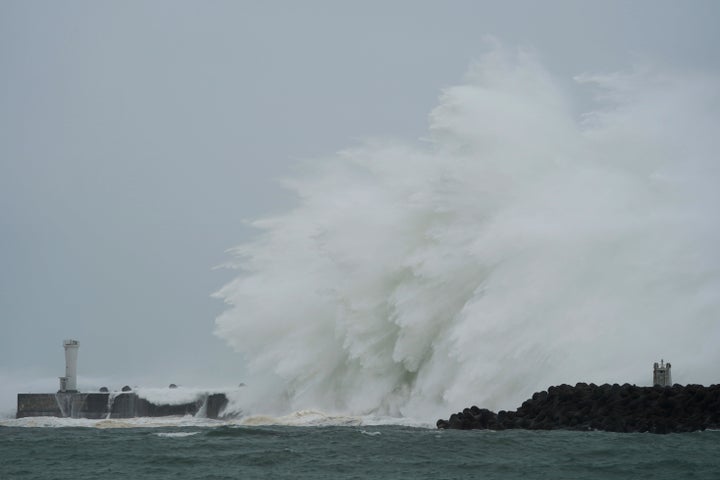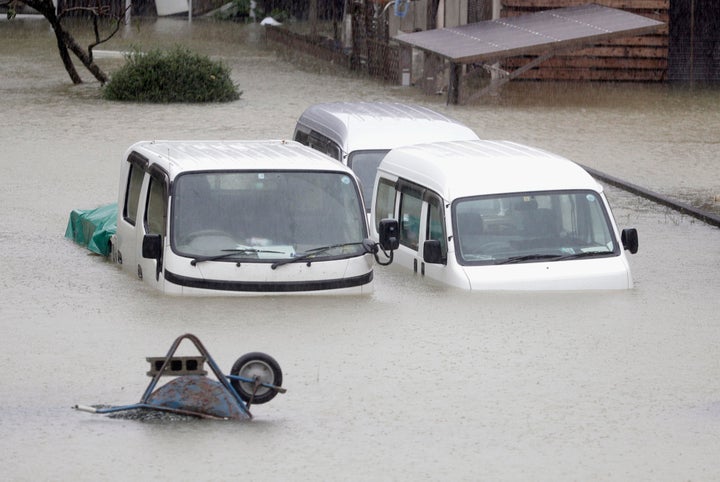TOKYO (Reuters) ― One man was killed, more than 60 people were injured and more than six million people were advised to evacuate as a powerful typhoon bore down on the Japanese capital on Saturday, bringing with it the heaviest rain and winds in 60 years.
Typhoon Hagibis, which means “speed” in the Philippine language Tagalog, made landfall on Japan’s main island of Honshu on Saturday evening, bursting some river banks and threatening to flood low-lying Tokyo as it coincides with high tide.
The storm, which the government warned could be the strongest to hit Tokyo since 1958, brought record-breaking rainfall in many areas, including the popular hot spring resort town of Hakone, with a whopping 939.5 mm (37 inches) of rain over 24 hours.

The Japan Meteorological Agency issued the highest alert level for 12 prefectures, including Tokyo, warning of amounts of rain that occur only once in decades.
“Damage from floods and landslides is likely taking place already,” an agency official told a news conference carried by public broadcaster NHK. “It is critical that people take action urgently to protect their lives and the lives of loved ones.”
Many people in and around Tokyo took shelter in temporary evacuation facilities earlier on Saturday before the worst arrived.
Yuka Ikemura, a 24-year-old nursery school teacher, was in one such facility at a community center in Edogawa in eastern Tokyo with her 3-year-old son, 8-month-old daughter and their pet rabbit.
She said she decided to move before it was too late.

“I’ve got small children to take care of and we live on the first floor of an old apartment,” Ikemura said.
“We brought with us the bare necessities. I’m scared to think about when we will have run out diapers and milk,” she told Reuters.
Tokyo’s Haneda airport and Narita airport in Chiba both stopped flights from landing and connecting trains were suspended, forcing the cancellation of more than a thousand flights, according to Japanese media.
Kanagawa prefecture officials said they would release water from the Shiroyama dam, southwest of Tokyo, and alerted residents in areas along nearby rivers.
Heavy winds have already caused some damage, particularly in Chiba east of Tokyo, where one of the strongest typhoons to hit Japan in recent years destroyed or damaged 30,000 houses a month ago.
A man in his forties was killed in an overturned car in the prefecture early on Saturday, while five people were injured as winds blew roofs off several houses, according to NHK. Several people were missing in a town near Tokyo after a landslide destroyed two houses, NHK said.
A number of municipal governments issued evacuation orders to areas particularly at risk of floods and landslides, including some in the most populous Tokyo region.

Experts warned that Tokyo, while long conditioned to prepare for earthquakes, was vulnerable to flooding.
Tokyo, where 1.5 million people live below sea level, is prone to damage from storm surges, Nobuyuki Tsuchiya, director of the Japan Riverfront Research Center, told Reuters.
“We are heading towards high tide. If the typhoon hits Tokyo when the tide is high, that could cause storm surges and that would be the scariest scenario,” he said. “People in Tokyo have been in a false sense of security.”
More than 150,000 households have lost power, including in Chiba, which was hit hard by typhoon Faxai a month ago, NHK said.
The Defence Ministry set up a new Twitter account to disseminate information on disaster relief efforts.
Stores, factories and subway systems have been shut down as a precaution, leaving Tokyo’s usually bustling shopping and entertainment districts such as Shibuya and Ginza deserted.
Japanese Formula One Grand Prix organizers canceled all practice and qualifying sessions scheduled for Saturday. Two matches of the Rugby World Cup due to be played on Saturday were also canceled.
Typhoon Ida, known as the “Kanogawa Typhoon” in Japanese, killed more than 1,000 people in 1958. (Reporting by Makiko Yamazaki, Kiyoshi Takenaka and Chang-Ran Kim; Editing by Paul Tait, Shri Navaratnam and Raissa Kasolowsky)
REAL LIFE. REAL NEWS. REAL VOICES.
Help us tell more of the stories that matter from voices that too often remain unheard.
Credit: Source link